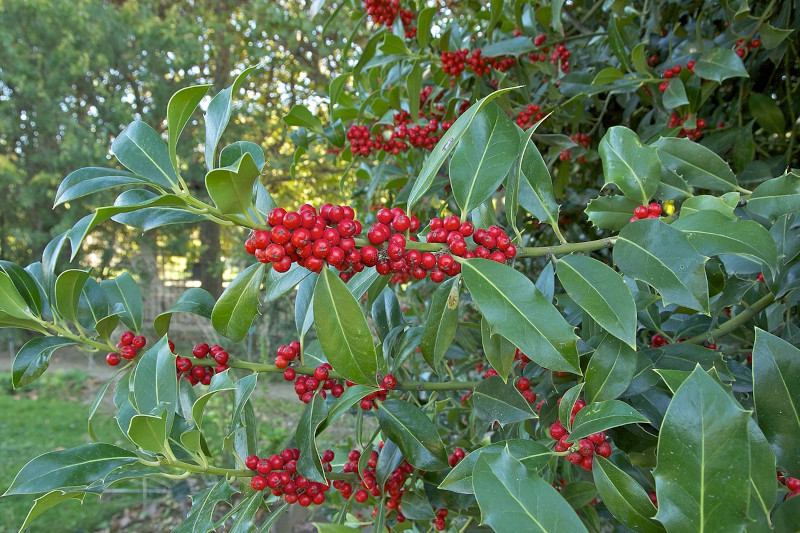Common Holly Facts
- This magnificent creation of Nature and evolution most frequently goes by the general name of the Common Holly across much of its native range. Yet, it also holds several other common names. In this respect, it’s like many other species around the world.
- These alternate terms include such informative names as the Christmas holly, due to its cultural usage. Others, however, include English holly, European holly, or simply holly. Regardless of which of these one uses, it’s a beautiful and intriguing variety of flora.
- Among scientific professionals, though, it’s generally referred to by its technical name. That’s the relatively simple, though perhaps less appealing, term of Ilex aquifolium. It’s a member of the only genus in its Family, which currently contains at least 560 species.
- It further received its technical name at the hands of the renowned Swedish botanist, Carl Linnaeus. He made the first formal recognition of it as a separate and distinct species. The scientist accomplished this scientifically noteworthy recognition in 1753.
- Fortunately, the Common Holly merits its name. That’s because its populations appears to be both stable and sufficient. This also seems to hold true throughout the entirety of its range. The IUCN, therefore, presently list it as Least Concern on its Red List.
- The gorgeous Angiosperm nevertheless does face potential threats to its existence. Due to human expansion, habitat loss might one day threaten it. Its greatest danger, however, likely consists of the ever-increasing effects of ongoing climate change.
Related Articles
Common Holly Physical Description
Despite its deceptive name, the Common Holly is anything but ordinary. It is, in fact, quite special, for various reasons. Chief among those, perhaps, comes its remarkable versatility. That’s due to the fact that the variable evergreen appears as either a shrub or tree.
Due to that variability, sheer physical size often varies significantly. The larger specimens, developing as trees, frequently reach heights in excess of 33 ft (10 m). Typically, however, it develops as a shrub. These usually range from 6.6 – 9.8 ft (2 – 3 m) in height.
Exceptional specimens of the flora do exist, though. A few of these outstanding individual plants measure as much as 82 ft (25 m) in height! Regardless of the heights various examples attain, however, its overall physical characteristics remain otherwise quite similar.
The central structure of the plant consists of a tall woody stem. The diameter of this obviously varies, depending on how tall the plant grows. Generally speaking, though, this measures between 16 – 31 in (40 – 80 cm) in diameter. But, a few have reached 39 in (99 cm).
From this central feature, numerous leaves branch off. This foliage further averages 2 – 4.7 in (5 – 12 cm) in length, and 0.8 – 2.4 in (2 – 6 cm) in width. These also have an evergreen nature, being a darker green on the upper surface, and lighter on the underside.
Meanwhile, the flowers of the Common Holly provide a dazzling color contrast. These manifest as bright white, and in copious numbers. The fruit also augments the beauty of the amazing plant. Though quite small, these appear as either a very bright yellow or red.
- Kingdom: Plantae
- Phylum: Trachyophyta
- Class: Angiosperms
- Order: Aquifoliales
- Family: Aquifoliaceae
- Genus: Ilex
- Species: I. aquifolium
Common Holly Distribution, Habitat, and Ecology
Fortunately for the intriguingly-named Common Holly, it evolved as endemic to a relatively broad swathe of the globe. That’s because it’s native to portions of three continents. Those regions include southwest Asia, northwest Africa, and southern and western Europe.
Due to human activities, though, it’s now been spread to other parts of the world. In some of those regions, however, it’s now become considered an invasive species. That’s especially true, though, on the east coast of North America, from Canada to the United States.
In all regions it appears in, however, the plant demonstrates the same environmental preferences. Due to that, the vast majority of specimens appear in relatively moist regions. Despite this, it’s proven to be remarkably hardy, enduring both drought and frost.
The tantalizing flora possesses further defining preferences, though. It most often develops, and thrives, in various types of temperate forests. It also demonstrates a preference for the presence of a high percentage of deciduous trees, especially native oak varieties.
Within its native range, the Common Holly only merits the adjective in terms of frequency of presence. In the local ecosystem, it plays a vital role. Many animals, ranging from birds to deer, also frequently take refuge within its dense, thorny, labyrinthine structure.
Its flowers provide a further benefit to its local wildlife. Numerous bees, flies, butterflies, and wasps flock to them for nectar. Following the first frost, its fruits drop to the ground. These thus serve as a ready food source for winter birds, who subsequently spread its seeds.
Species Sharing Its Range
Check out our other articles on 5 Befuddling Invertebrates of Borneo, Porbeagle, Fraser Island, Giant African Land Snail, Wilson’s Bird-of-paradise, Rough-nosed Horned-Lizard

